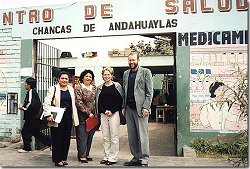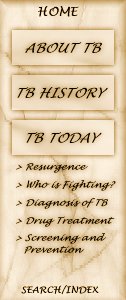
Treatment of Tuberculosis
Directly Observed Therapy (DOT) |
 |
|
The Directly Observed Therapy is the process whereby the ingestion of every dose of medication is directly observed. This method overcomes the problem of patients not taking their medicine as prescribed, which will lead to drug resistance.
Directly Observed Therapy (DOT) was started in 1990. Prior to this, in 1986, 26% of patients became drug resistant. The rate of drug resistance was lowered to 7% through the use of DOT. Under this program treatment lasts approximately 6 months.
According to the World Health Organization (WHO),
"DOTS is the only TB control strategy to consistently produce 85 percent cure rates. WHO's TB control targets are to cure 85 percent of the detected new smear positive TB cases and detect 70 percent of estimated cases. DOTS is also one of the most cost-effective health interventions, compared to those available for other diseases."

|
|
| Members of a Canadian (CIDA) delegation pose in front of a Health Centre in Peru. Locals come here to receive DOTS therapy. | |
